 |
The Colorado Coalfield War1913-1914 |
|
|
 The Ludlow tent colony before the fire |
|
Disaster stalked coal miners, especially in early Colorado where fatality rates were double what they were everywhere else in the world. The workers had many grievances against the powerful coal companies but they could not talk to the mine owners because they had no union and no bargaining power: this is how the mine owners wanted it. Anyone who spoke up was immediately fired. And as most workers lived in company housing, anyone fired also had his family immediately put on the street. The high death tolls reflected the gross negligence in regards to safety on the part of the mine owners. And most mines in this area were owned by John D. Rockefeller and/or his cronies. |
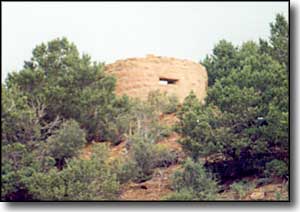 This watchtower was built on a hilltop for the mine guards to watch over the mining camps In 1913, a group of miners drew up 7 demands and presented them to the mine owners. These demands consisted of: Union recognition, a raise in wages, an eight-hour work day (which was already a state law but was generally ignored), hourly pay for dead work (work that didn't directly produce coal), a check weigh-man at all mines (to be elected without interference from company officials), the right to trade in any store they chose, the right to select their own living places and doctors, the enforcement of Colorado mining laws and the abolition of the guard system that had run the camps for so many years. This was a hard one for the owners. For years they had fought every attempt at union organization with very blunt tactics. Union miners were fired, tarred and feathered, beaten, and threatened, or rounded up and deported across state lines to be abandoned on remote stretches of prairie. When the union movement gained enough strength to call a strike, the companies retaliated by swiftly importing laborers. They sent recruitment ads to foreign countries boasting of the United States as a "land of milk and honey where the streets are paved with gold." Desperate workers came in droves, only to find that they had been blatantly lied to and had been enticed to come here only to replace striking miners. By 1911, 27 different languages were being spoken in the streets of Trinidad, spoken by people who had been brought in from overseas to work in the coal mines. |
 Ludlow Schoolhouse today When the 7 demands were presented to the coal mine owners, the owners chose to ignore them. Consequently, the union organizers called for a general strike to begin on September 23, 1913. Using union funds, lands east of the coal camps were rented. Union officials then ordered tents and quietly established tent colonies on the plains for the striking miners and their families. Thousands of miners set up housekeeping in the flimsy tents, confident the strike would be over soon. At the same time, the mine owners invested heavily in more detectives, more guards and lots more rifles and ammunition. The John D. Rockefeller-owned Colorado Fuel & Iron (CF&I) steel mills in Pueblo built an armored car for the company. It had bulletproof sides and machine guns mounted on the back. It was nicknamed "the Death Special" by the miners because the gunmen who used the car took perverse delight in spraying bullets through the tents as they roared past the colonies on their way to and from the various mine offices. It happened so often at Ludlow that the men dug holes under their tents for their families to crawl into as protection against the flying bullets. On October 17, 1913, Baldwin-Felts detectives in the Death Special shot up the Forbes colony, killing several people. One young boy running from the gunfire had 9 bullet holes in his legs. They discovered that one of the tents had over 85 bullet holes in it (the union shipped this tent to the East Coast and put it on display to show the rest of the world what was happening in Colorado). On October 28, 1913, Governor Ammons called out the Colorado National Guard. He issued orders that the troops be impartial in their handling of the situation and that no present or former coal company guards and gunmen were to be enlisted for service during this crisis. Within just a few months, most members of the Colorado National Guard troops who were stationed in the Ludlow area were replaced by coal company gunmen anyway. |
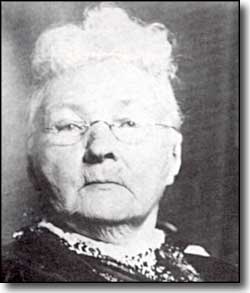
The winter of 1913-1914 was one of the worst in recorded Colorado history. Food was scarce and the tents were cold and wet. In January 1914, Mother Jones (that's her on the left) arrived in Trinidad. Even though she was over 80 years old, the mine owners had her arrested immediately and confined in a psychiatric ward at Mt. San Rafael Hospital (the police said she was crazy and they were arresting her for her own protection: she must have been crazy, she very vocally opposed John D. Rockefeller). On January 21, 1914, some of the miners' wives and children organized a parade to protest her arrest. Adjutant General Chase, commander of the Colorado Militia, was so furious he confronted the women and, in the excitement, fell off his horse. The women laughed and humiliated him with derogatory remarks about his prowess as a horseman. Embarrassed, he gave orders to "Ride down the women!" His mounted troops then attacked the women and children with their sabers drawn and injured quite a few. By spring, the cost of keeping the National Guard in place was bankrupting the state. Governor Ammons withdrew all but two of the troops from the field, these two troops being composed mostly of company men (mine guards and gunmen), and both of these troops were stationed near Ludlow. On April 20, 1914, a series of 3 signal bombs went off in the military camp. After the third one, bullets began ripping through the tents at Ludlow. Women screamed and people dodged. Children ran for their lives and hid in the basements under each tent. That evening, soldiers raced into the colony on horseback with burning, kerosene-soaked brooms, and torched the tents. Louis Tikas, leader of the Ludlow tent colony, was captured soon after the burning of the tents and was taken back to the National Guard camp. There, a Lieutenant Linderfeldt swung once and bashed the side of his head in with a rifle, and as Tikas turned and staggered away, Linderfeldt shot him 3 times in the back. Accounts say that his body and those of two others killed in the same fashion lay on the ground where they fell for a long time. Many of the families were marched by the bodies as the militia gathered people up and transported them to Trinidad on the train. At the camp itself, the death toll included 4 men, 2 women and 11 children. All the women and children were found suffocated in the dugout beneath one of the burned tents. The bodies of the victims were taken to a mortuary in Trinidad where a suspicious fire broke out. The bodies then had to be hauled into the street to keep them from being burned a second time and destroyed as evidence of the massacre. |
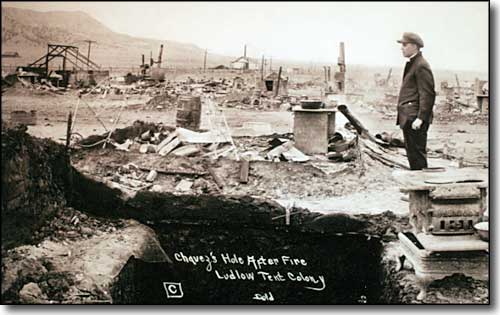 Ludlow tent colony after the fire |
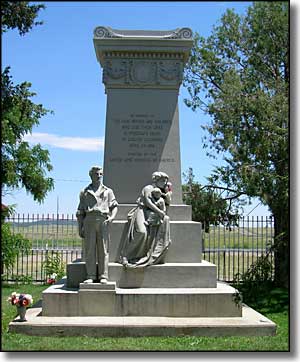 Ludlow Massacre Memorial During the days that followed, the miners retaliated by attacking coal mines in the valleys west of the tent colonies. They set fire to dozens of mine installations and dynamited thousands of dollars worth of mine buildings and workings. The atrocity at Ludlow was protested in cities all over the world and Federal troops were called in, arriving in early May, 1914. The United States Commission of Industrial Relations, a body appointed by President Woodrow Wilson, made an investigation of the massacre and concluded "the State of Colorado through its military arm was rendered helpless to maintain law and order because that military arm acted, not as an agent of the commonwealth, but as an agent of the coal operators against the striking miners." In reality, the miners lost the strike. The fighting went on for a while but after attending the funerals in Trinidad, most of the miners went back to work in the mines. Their working situation didn't change for years. In 1917, just three years later, a few miles north of the massacre site, the Hastings Mine blew up. It was the worst mine explosion in Colorado history with 121 men dying in the notoriously gassy mine. Colorado finally began to enforce the state's mining safety and labor laws in Las Animas County in the 1920's. As the level of state enforcement of the safety and labor laws grew, many of the coal mine operators chose to close their mines rather than make them safer places to work. And having to pay their workers fairly for their production and an eight-hour-day on top of that: it was simply too much to ask of some of America's wealthiest people (especially those who had made their fortunes on the backs and in the blood of these very same miners). They closed the mines, bulldozed the buildings (so that squatters couldn't make any use of the properties) and took advantage of the tax breaks offered by the Federal government... and with the overall decrease in coal production, they were able to raise the price of the coal they still did produce... isn't this the Holy Grail of all business theory: to downsize and raise profit margins at the same time? Update: In 1990, Colorado Fuel & Iron went bankrupt. At that point, researchers finally gained access to paperwork that had been hidden in the back offices for years and it became obvious that John D. Rockefeller (and his nearest associates) had systematically spied upon, disrupted and worked to discredit all union activities around the coal mines of Colorado in the early 1900's. Other paperwork showed how Colorado's state government was corrupted by Rockefeller's money. When the elder Rockefeller died and everything devolved to his son, conditions did not change for the better. |
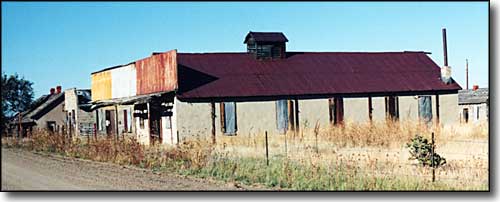 Ludlow Mercantile today 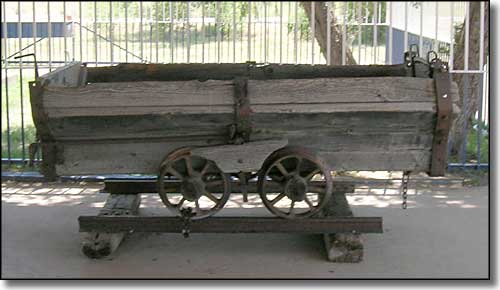 A coal cart at the Ludlow Memorial |
|
|
Colorado Pages
Towns & Places - Scenic Byways - State Parks - BLM Sites - History & Heritage
Ski & Snowboard Areas - Photo Galleries - Colorado Mountains - Scenic Railroads Unique Natural Features - Wilderness Areas - Outdoor Sports & Recreation Colorado's National Forests - National Wildlife Refuges - Colorado's National Parks |
 |
| Index - Arizona - Colorado - Idaho - Montana - Nevada - New Mexico - Utah - Wyoming National Forests - National Parks - Scenic Byways - Ski & Snowboard Areas - BLM Sites Wilderness Areas - National Wildlife Refuges - National Trails - Rural Life Sponsor Sangres.com - About Sangres.com - Privacy Policy - Accessibility |
| All black and white photos are courtesy of the Colorado Historical Society Color photos courtesy of Sangres.com, CCA ShareAlike 3.0 License. Text Copyright © by Sangres.com. All rights reserved. |